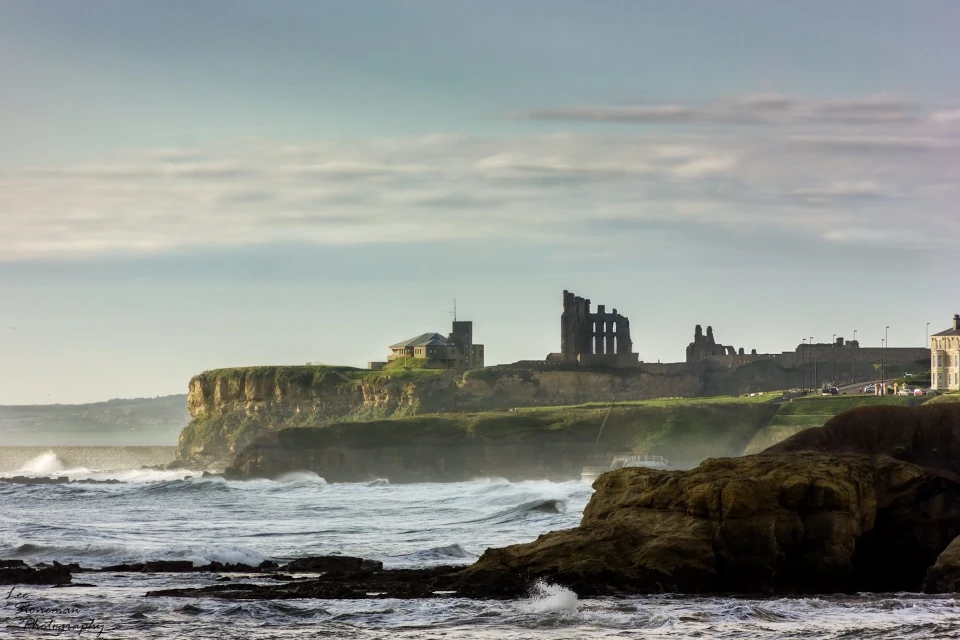A RAMBLE
IN TYNEMOUTH AND
CULLERCOATS.
HISTORICAL NOTES

BY
WILLIAM S. GARSON.
(1924)
FOREWORD.
I HAVE had the privilege of reading the proof sheets of “A Ramble in Tynemouth and Cullercoats,” and feel sure that this excellent little book will be welcomed by the public. It is a picturesque description of our two seaside villages, and the care and finish which Mr. Wm. S. Garson shows in his writing prove the love he has for his native town and its history. To the visitors who want a guide to Tynemouth and Cullercoats I can recommend the book with confidence. It supplies a real need and does so in a worthy manner. Mr. Garson seems to have a clear perception of the curiosity and thirst for information in the mind of every intelligent visitor to a romantic district like this one. Every point in the two seaside villages about which any important historical facts are known or which has any picturesque quality, Mr. Garson describes with a vivid pen. Those who follow him in his “Ramble” will find they have had a pleasant and profitable tour. To the resident also the book will be valuable. Only a few are steeped in the history of the district, and there will be fewer still (if any) who cannot learn something new from the facts which Mr. Garson has woven together with such skill.
HAROLD TAYLOR,
Editor, “Shields Daily News,”
A RAMBLE
IN TYNEMOUTH AND CULLERCOATS.
BY WILLIAM S. GARSON.
TYNEMOUTH, without a doubt, ranks high among the beauty spots on the north-east coast of England. It is a Municipal. Parliamentary, and County Borough, situated at the mouth of the River Tyne, about nine miles from the City of Newcastle, and is an excellent seaside resort, noted for its facilities for boating, swimming, cycling and golf, with excellent hotels among the latter the “Bath” and the “Grand” are delightfully situated within five minutes’ walk of the Railway Station.
It has natural charm with a certain peace and quietude; the walks in the vicinity present remarkably pleasing views, and within a radius of a very few miles are many beautiful places rich in historical associations. The ramble, which we will take. together, is through familiar scenes, viewed in the light of their historical associations.
TYNEMOUTH RAILWAY STATION.
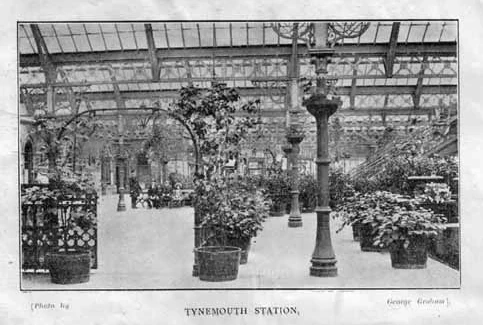
A convenient starting-point will be Tynemouth Railway Station, which has a fame second to none in the United Kingdom, for it has carried off the first prize year after year for the best-kept wayside station. It was in the year 1882 that the present commodious station was opened, and is a great improvement on its predecessor.
In June, 1903, the late Earl Roberts, who was a visitor, said, “Tynemouth Station is the prettiest station I have seen in all my travels.” The late Mr. Joseph Chamberlain, M.P., also a visitor in October of the same year, was greatly struck with the decorations and congratulated the then stationmaster (Mr. James Lee) and his staff.
TYNEMOUTH FRONT STREET.
We leave the Station by the north approach and make our way towards the wide thoroughfare known as Front Street, which has often been referred to as a very fine avenue to the Castle and Priory.
On our left side we pass what was known as the Village Green, where, on “fair” days, both sides of the green were lined with stalls for the sale of corn, cattle, etc., whilst the travelling circus folk held their shows in the centre. In the time of the Priors a cross stood on the green, from the steps of which the legal proclamations and general announcements were made to the listening rustics and tenants of the village.
The green is now enclosed, planted with trees and flowers.
The first memorial we come to was erected to the local men who fell in the Boer War, and at the east end of the green is a bronze statue of Queen Victoria, commemorating her long and glorious reign. There is also a temporary memorial to the Tynemouth boys who fell in the Great War.
On our right is the Congregational Church, with its graceful spire, 180 feet high, built in 1865-a landmark for miles around. The pastor, the Rev. Samuel Pearson, M.A., has ministered to this church for 35 years. Adjoining the church is St. Oswin’s Hall.
HARRIET MARTINEAU.
We continue along the right-hand side of Front Street to No. 57, now converted into a shop. Here, from March 16th, 1840, to January, 1845, lived Miss Harriet Martineau, the celebrated authoress. She occupied two rooms on the first floor of this house, overlooking the Priors’ Haven, and it was here that some of her novels were written, viz.: “The Hour and the Man,” “Settlers at Home,” “The Prince,” “Feats on Fiord,” “The Crofton Boys,” and “Life in the Sick Room—Essays by an Invalid,” etc. In this last book she speaks in glowing terms of the beautiful, ever-changing view which she enjoyed from the windows of her rooms overlooking the mouth of the Tyne and the Durham coast-country.
Harriet Martineau came to Tynemouth after a trip to Venice, being very ill when she arrived, but, happily, left fully restored.
During her stay she was visited by a number of famous people. Among these were Thomas Carlyle and Mrs. Carlyle, who stayed for a week in Front Street, the then only residential street in the village, in the summer of 1841.
Shortly after Carlyle’s visit the three antiquated cottages, which stood on the site of Percy Gardens, were pulled down to make way for the present streets and terraces.
Before we move along I must just mention that Well Close Square, at the rear of Percy Street, is 300 years old, and stands on the site of an old woollen mill.
Proceeding eastward, we have on the right, withdrawn a little from the street, the Roman Catholic Church of Our Lady and St. Oswin and Martyr’s Peace, dedicated to St. Mary and St. Oswin. This is the residence of Dr. J. Thorman, the present Bishop of Hexham and Newcastle.
On the opposite side of the street is the Wesleyan Chapel. This is the third church in Front Street.
Close to the aforementioned is the Turk’s Head Hotel, in the bar of which can be seen, in a large case, the preserved remains of a collie dog named “Wandering Willie.”
“WANDERING WILLIE.”
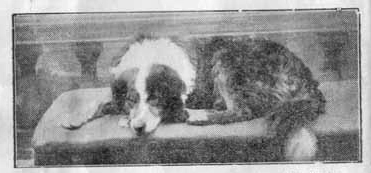
I am still poor Wandering Willle,
Many voyages have I been:
Dogs like me are not so silly,
I am just as good as aught I’ve seen*
*Inscribed on the dog collar given by the Committee of the Jarrow Dog and Poultry Show, November 10, 1875.
In the early seventies of the last century a shepherd, on his way from the Cheviots to the Cleveland Hills with a flock of sheep, crossed the river by ferry at North Shields. On reaching the south side the flock took fright and scattered in all directions. The dog went in pursuit of the runaways and brought them all back to his master. At the first count one of the number appeared to be missing, and the shepherd dispatched his dog to find it.
On making a second count the shepherd found that his flock was complete and he decided to proceed without his dog. Late at night the dog returned to the ferry after a fruitless quest.
From that time until his death “Wandering Willie” attached himself to the ferries, ever looking for his master. One of the ferryboat crew, Mr. Ralph Cruickshanks, became greatly attached to the dog and taught him to guide the ferry passengers to the railway stations at North and South Shields.
Afterwards the ferry crew had a little money-box placed round Willie’s neck, and he collected for the orphans of ship-wrecked sailors.
The animal died from old age in April, 1882, and its remains were stuffed and placed in a showcase at the Turk’s Head Hotel.
THE DRINKING FOUNTAIN.
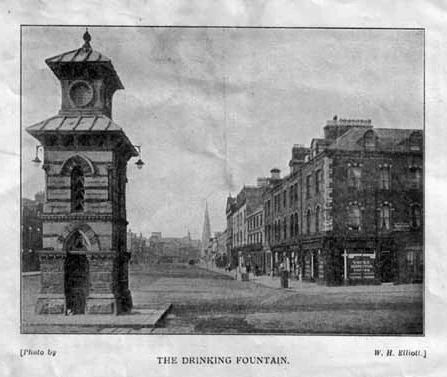
The drinking fountain, near the entrance to the Castle, was a happy inspiration on the part of Mr. William Scott, of London, who visited Tynemouth in 1860, and was so captivated by its many charms, and received such benefit by his stay, that he presented Tynemouth with this drinking fountain.
TYNEMOUTH BARRACKS.
Across the road, and opposite to the fountain, is the winding carriageway leading to the massive gateway of the Tynemouth Barracks, through which we reach the Priory. At one time there were two walls enclosing these buildings the outer wall enclosed some six acres of ground. The grass-grown moat is not ancient work; it was excavated in 1851 with the double object of strengthening the defences and obtaining stone for the construction of the pier, a hope in which the contractor for the latter was disappointed, for the stone proved to be of too soft a nature to be of any use. During the excavations a Roman tile, Roman altars and coins were found, which seem to point to a Roman occupation of the headland. Originally there was a small trench and a drawbridge, fortified by moles on each side. The trench could be filled with water from a fish-pond which was fed from a spring arising in Priors’ Park. The pond itself belonged to the monks, who were in the habit of procuring their supply of fish from it during Lent, if the weather proved to be too stormy for them to fish at sea.
The original Castle was built in the year 1095, and since 1800 two storeys have been added to it to make the present barracks. To enter the Castle Yard we pass along the vaulted passage of the barbican and, beneath the gate-house, notice the grave in which worked the portcullis.
Copies of “A Ramble in Tynemouth and Cullercoats,” and “The Origin of North Shields,” may be obtained in this street from T. Robson, Hairdresser, and Pallister’s Tynemouth Bazaar.
TYNEMOUTH PRIORY.
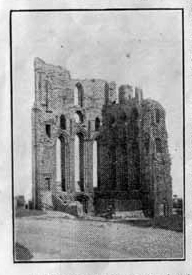
Immediately in front of us are the glorious ruins of the Priory, situated on the rugged promontory overhanging the sea, known to the ancient Britons as Pen Bal Crag. The weather-beaten walls. are a prominent landmark for sailors, especially those endeavouring to make the port of the Tyne.
The last record is in the eleventh century by John of Tynemouth, who mentions a church built of wood, named St. Mary, which had existed at Tynemouth and in which Rosella, daughter of King Edwin (the founder of Edinburgh), took the veil. In 633 King Edwin died, and was succeeded by King Oswald, who embraced Christianity; he rebuilt the chapel in stone, and dedicated it to the Blessed Virgin.
In the year 671 it was plundered and destroyed by Danish pirates. The Church of St. Mary was afterwards rebuilt, and was attacked by the Danes in the years 800 and 832; and in 875. during the reign of King Alfred, the Danish pirates set fire to the monastery and reduced it to ashes. The defenceless nuns from St. Hilda’s Convent at Hartlepool, who were staying at St. Mary’s Church for safety, were massacred, or, as the chronicler has it, “translated by martyrdom to heaven.” This deed was accomplished by an army under Halfdene, the Danish King, and for many years afterwards the place was deserted and forsaken.
A remarkable dream of Edmund the Sexton, in which he saw the radiant form of the martyred body of King Oswin, who fell a victim to the ambition of Oswy, King of Bernicia, Prince of Northumberland, in 651, had revealed the fact that his body was buried in the church at Tynemouth. Diggings were made, and the relics discovered on the 1st March, 1065. Pilgrims were attracted to the shrine of St. Oswin, and Tynemouth became a place of special sanctity, persons who died in the vicinity being interred within its walls.
In 1090 the Castle was given to Earl Mowbray of Northumberland by William I., and he refounded the Monastery, filled it with Black Canons, and made it a cell to St. Alban’s in Hertfordshire. He fortified the peninsula on which the Priory stood, and here he was held in siege for two months by the forces of the Red King Rufus, whom he had attempted to dethrone. The Castle was taken by storm, and Mowbray fled to Bamburgh Castle; however, finding himself insecure, he returned to the sanctuary, but was dragged from the altar and put to death. During this siege the Monastery was reduced to a ruin for the seventh time.
Early in the thirteenth century the present magnificent early English convent church was rebuilt with hewn stone brought from the Roman station at The Lawe, South Shields; those beautiful ruins to this day have withstood the storm and fury of the gales which have dashed many ships and hundreds of human lives at their feet.
A letter from one of the monks of Tynemouth to a comrade in St. Alban’s in a vivid picture thus describes the discomforts and misery endured on this exposed crag: “Thick sea-frets roll in, wrapping everything in gloom. Dim eyes, hoarse voices, sore throats are the consequence. Spring and summer never come. The north wind is always blowing. Birds nest in the rocks and greedily prey upon the drowned. The people who live by the shore feed upon black, evil-smelling seaweed; the constant eating of it turns their complexions black. The sea air blights the blossoms; you think yourself lucky if you find a wizened apple, but it will set your teeth on edge. See to it, dear brother, that you do not come to so comfortless a place. But the church is of wondrous beauty.”
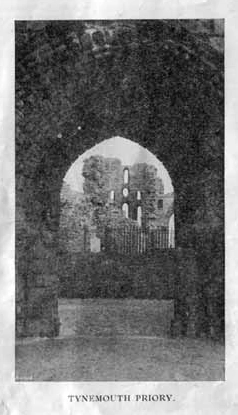
THE LADY CHAPEL.
The little Percy Chapel at the extreme end of the Priory, under the east windows, which is commonly known as the Lady Chapel, was built in the reign of Henry IV., and the only part that is in complete preservation. It has a vaulted ceiling of considerable interest, for, carved on the bosses at the intersection of the ribs, are a number of sacred figures and emblems, monograms and badges of the Percy family, with decorations of a circle of angels blowing trumpets, and the Saviour in the midst, also the Virgin Mary and the twelve Apostles.
The chapel is only 18 feet in length and 12 feet in breadth. The rose window is said to be the best of its kind between York and Edinburgh.
ROYAL VISITORS TO TYNEMOUTH PRIORY.
One of our greatest soldiers, King Edward I., was a frequent visitor to the Priory, and, in 1299, came for the fourth time with an offering of a clasp of gold. He also brought his youthful bride, Marguerite, the Flower of France; she stayed at the Priory whilst the King was in Scotland in 1303.
His successor, Edward II., of Bannockburn, spent some days with the monks in 1312, and left his Queen, Isabella, behind him; and Edward III, the father of the Black Prince, and the victor in many a hard-fought battle in France, came with a cloth of gold for the shrine of the saint in 1335.
King Charles I was a visitor on three occasions during his troublous reign. The first visit was on June 5, 1633, whilst on his way to Scotland to be crowned. He was conveyed by the master and brethren of Trinity House in their barges to the Governor Tree at Pow Burn, being received by the Commander of Tynemouth Castle.
After his surrender to the Scots at Newark in 1646 King Charles entered Newcastle some days later, and on May 21 he went in a barge to Sheeles and dined with the Governor at the Castle in the great room of the gate-house, which is still to be seen. His last visit took place on September 2, 1646.
Tynemouth Priory shared the fate of most of the religious houses in the reign of Henry VIII. On January 12, 1539. Robert Blakenay, the last Prior of St. Mary and St. Oswin’s, signed the deed of surrender into the hands of the King’s officers, and the burning of lights before the shrine of St. Oswin was done away with, and the lamp before the high altar was extinguished for ever. St. Oswin’s shrine was broken up and his bones scattered. The six bells, 62 ounces of gold, and 2,000 ounces of silver were carried off by the King’s officers, and the beautiful buildings were dismantled and ruined for the sake of their materials.
The church was parochial until 1650. In that year part of the roof fell in and killed several soldiers who were quartered there; the services in it were finally discontinued in 1668, and a new church was built at North Shields. It is now known as Christ Church, and was opened by Bishop John Cosin of Durham during the reign of Charles II.
Since 1904 the ruins have been cared for by the Office of Works, who are to be complimented on their work of restoration.
Perhaps one would like to read over and hum the refrain of that popular song, “Tynemouth Abbey,” composed by John Stobbs, of North Shields, and set to music by Thomas Haswell, “The Maister,” an enthusiastic musician, who for sixteen years was the organist at Christ Church, and for forty-eight years was Master of the Royal Jubilee School at North Shields.
Permission to reproduce this song has been kindly granted by the publisher, Mr. George March, Camden Street, North Shields, where copies may be obtained at 2/- each.
“TYNEMOUTH ABBEY.”
Where the sable seaweed’s growing,
Tynemouth on thy rocky shore,
“Tis sweet to hear the wild winds blowing
And the restless ocean roar.
Where yon Abbey ruin stands hoary,
Nodding o’er the sounding deep;
Where yon Abbey ruin stands hoary,
And the dead in silence sleep.
By thy silver, sheeny waters,
Rippling on thy yellow sands,
Often have thy beauteous daughters
Watched the back from distant lands
Where yon Abbey ruin stands hoary,
Nodding o’er the sounding tide,)
Where you Abbey ruin stands houry,
And the dead lie side by side.
How many now in death are sleeping
Neath that graveyand’s grassy sod,
Who often, ons summer’s evening,
Around those airy walks have trod.
Where you Abbey ruin stands hoary,
Nodding o’er the soundings,
Where yon Abbey ruin stands hoarz,
And the dead sleep silently.
When the silver moonlight stealing
Softly through the evening air,
Distant forms is half revealing.
Sweet it is to wander there.
Where yon Abbey ruin stands hoary,
Nodding o’er the sounding deep:
Where you Abbey ruin stands hoary,
And the dead in silence sleep.
In the Lady Chapel, lowly
Bending down on reverent knee,
High-born dames and pilgrims holy,
Knights and minstrels once would be.
Where yon Abbey ruin stands hoary,
Nodding o’er the sounding tide,
Where yon Abbey ruin stands hoary,
And the dead lie side by side.
Oft when on the storm vex’d billow,
From his kindred far away,
Dreams will haunt the sea-boy’s pillow,
Of thy rocks and ruins grey.
Where yon Abbey ruin stands hoary,
Nodding o’er the sounding sea,
Where son Abbey ruin stands hoary,
And the dead sleep silently.
TYNEMOUTH LIGHTHOUSE.
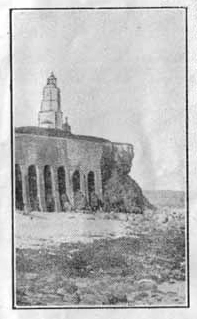
At one time the Tynemouth lighthouse, a lofty structure, was a prominent landmark; it stood on the north side of the ground which was formerly the Priory garden, and in clear weather the old red light was visible seventeen miles out at sea and was a pleasant sight from the piers below as it shed its rays to the distant mariner groping his way through the darkness to some desired haven. The lighthouse was established about the year 1662 as a coal fire, which was superseded by an oil light on March 11, 1802, and was discontinued on August 31, 1898. On that date a light was exhibited for the first time on St. Mary’s Island, the lighthouse on which was erected to take the place of the Tynemouth Castle lighthouse, the latter being razed to the ground, to the very great regret of every lover of the sea.
JINGLING GEORDIE’S HOLE.
Passing out of the great gate of the Castle Yard, to our right we overlook the Short Sands, or Percy Bay as it was known. If you overlook the wall here at the north-west corner you can see a fragment of Jingling Geordie’s Hole, which was once part of the monastic building and connected with the Abbey by an underground passage. This spot has been the scene of many perilous adventures to discover, if possible, the extent and mysteries of the cave. The entrance was through an opening in the face of the rock, being made partly of masonry; the inside consisted of two large apartments excavated in the rock and contained a twelve-feet dry well.
It is recorded that at one time a hermit existed there. Some say he was a wrecker who exhibited lights at the mouth of the cave to lure ships on to the rocks.
In December, 1886, the subsidence of the cliff carried away Jingling Geordie’s Cave, and access to the place is dangerous. The romance of its magic treasures will ever be associated with the cliffs of old Tynemouth.
Looking across to the buildings at the commencement of the steps leading to the Short Sands, we can still see part of the cottage, below the level of the road, which was at one time inhabited by Willie Dean, where Thomas Bewick, wood-engraver, of Newcastle, lodged and wrote his “A Memoir of Thomas Bewick” in 1822, which was published in 1862. The cottage now forms part of the refreshment-houses.
TYNEMOUTH PIER.
Turning to our left we now go down the pier bank and walk to the end of the North Pier and drink in the fine, bracing air from the sea, enjoying a trip to sea without the necessity of leaving terra-firma.
The massive stone piers which now guard the entrance to the River Tyne are one of the greatest undertakings of the River Tyne Commissioners. The foundation-stones of these great breakwaters were laid by Mr. Joseph Cowen on Thursday, June 15, 1854, to the accompaniment of the firing of cannon and the ringing of church bells, and this was a “red-letter” day in the annals of the harbour boroughs.
The North Pier sustained considerable damage in the gale of January 23, 1897, when the sea, carrying away part of the pier, left a huge gap, and the new lighthouse, with a few hundred feet of pier attached, was completely isolated in the sea like an island. This necessitated the reconstruction of about half of the pier, the work being executed by Sir John Jackson & Co.
The total length of the pier is a little over three-quarters of a mile. The pier lighthouse is a fine granite structure; in stormy weather it is reached by an alley-way inside the pier.
The Tyne entrance between north and south is 400 yards wide, and is indicated to mariners by the two lighthouses. The depth of water in the channel at high tide is 50 feet. The bar, prior to the building of the piers, occasionally had so little depth of water that pilots actually waded across. It was ever a danger to navigation, but has now been fully dredged and is passable to the largest steamer afloat. Trade and commerce soon developed on the Tyne, which provides a harbour of refuge second to none, and is the dividing line between Northumberland and Durham.
The pier forms a pleasant promenade, and for natural beauty the view from the pier-end cannot be excelled: the banks of Tynemouth, the old Priory ruins, harbour, coastline north and south, constitutes scenery very pleasing to the eye.
To the north may be seen in the distance Newbiggin Church, standing like a sentinel over the vast expanse of water at its base, with its spire pointing heavenwards, directing the passing mariners to their source of help in times of distress, Midway, stands St. Mary’s Lighthouse, one of the most commanding objects on the coast.
It may be of interest to know that the great novelist Charles. Dickens paid a visit to Tynemouth, and humorously described his experience in a letter to his friend, the late Charles Stansfield, the famous artist, as follows: “I wish you had been with me one day on the pier at Tynemouth. There was a heavy sea running …suddenly there came a golden horizon and a most glorious rainbow burst out, arching one large ship as if she were sailing direct from Heaven. I was so enchanted by the scene that I became oblivious of a few thousand tons of water coming in a tremendous roller, and was knocked down and so completely wetted through that the very pocket-book was full of sea.”
Between the Castle and the river lies Priors’ Haven, sheltered by a projecting rock; here an old fort once stood named the Spanish Battery, which was built by Sir Richard Lee in the reign of Queen Elizabeth—and derived its name from the fact of a body of Spanish mercenaries having been placed in the new outwork.
THE BLACK MIDDENS.
The reef of rocks known as the Black Middens, which have a terrible record for scenes of wrecks, are situated near the foot of the rocky eminence on which the Life Brigade House stands. Hundreds of valuable lives have been lost upon them. Therefore it is not surprising that the very first lifeboat in the world should have been invented by a Shieldsman, namely, Willie Wouldhave, who was born in North Shields.
This good work, started over a century ago at the mouth of the Tyne, is still carried on, but on modern lines, i.e., by motor lifeboat, an invention which Tynemouth introduced in 1905.
On November 1, 1914, the hospital ship Rohilla, of 7,000 tons, with 229 souls on board, had become a total wreck off Whitby, with tremendous seas washing over her during a terrible gale, and some of the crew could be seen seeking safety in the rigging. The Whitby lifeboat had been badly damaged and rendered useless after it had landed two boat-loads of survivors. News of the disaster reached Tynemouth, and Major Burton, who was in command, along with ex-Coxswain Smith, made a forty-mile dash through the stormy night, and after a nine-hours journey, arrived at Whitby. At daybreak they proceeded alongside the wreck and took off the last 50 survivors, who had been on the wreck for more than fifty hours. This achievement will go down to posterity as one of the greatest examples of lifeboat heroism.
In the early part of 1924 the King received in audience at Buckingham Palace Mr. Robert Smith and Major H. E. Burton, R.E., and presented each of them with gold medals of the Lifeboat Service for the many gallant deeds they and their crew rendered during the Great War.
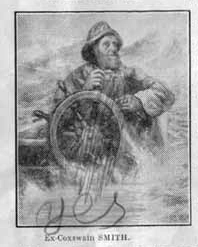
Henry Russell wrote his song of “Man the Lifeboat” at the Tynemouth Bath Hotel, after seeing a crew rescued from a wreck on the Herd Sands, at the south side of the river.
It was on these treacherous Black Middens that the historical Betsy Cains was wrecked in February, 1827, the crew being saved by the Northumberland lifeboat. Before changing her name from the Princess Mary to the Betsy Cains she had been purchased by the Prince of Orange, and played an essential part in the revolution of 1688, the Prince bestowing upon her that name in honour of his consort, the daughter of James II.
During the whole of William’s reign she held a place of honour as one of the King’s yachts, and after his death she was regularly used as a pleasure yacht of Queen Anne. Later she came into the possession of His Majesty King George I., and a few years afterwards she was sold and received her new name Betsy Cains. She still retained her reputation as “a tricky ship and a fast sailer”, heavy seas upon Black Middens, where she became a total wreck. The carved figurehead is still in the possession of the Master and Elder Brethren of Trinity House at Newcastle.
On November 24, 1864, the large two-funnelled passenger steamer Stanley was wrecked on the Black Middens and twenty-six of the passengers were drowned. So much grief was caused by the loss of this ill-fated ship that it was decided to form what is now known as the Tynemouth Life Brigade, the pioneer of many other life-saving organisations, and which holds the proud position of being the first volunteer life brigade for saving life from wrecked ships by means of rocket apparatus. It is equipped with an up-to-date life brigade house, whose watchers are ever ready to fire the rocket or hasten to the aid of “Those who go down to the sea in ships.”
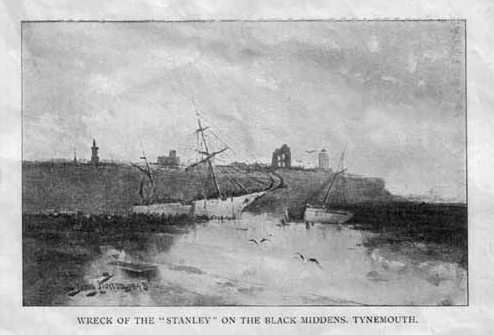
The code of wreck signals is made by gunfire, viz.: One for life brigade practice, two for lifeboat, three for a wreck on the south side, and four for a wreck on the north side.
The erection of the two magnificent piers at the mouth of the river has entirely removed the danger of these dreaded Black Middens.
TYNEMOUTH DOCK.
Near the outer edge of the rocks is a beacon known as the Skeleton Post, and near by is the foundation-stone of the proposed, but never consummated, Tynemouth Dock This foundation-stone was laid on Thursday, June 23, 1864, and constituted another great day at Tynemouth.
The Mayor of Tynemouth, Mr. Joseph Spence, presented Mr. Joseph Cowen, the chairman of the Tyne Improvement Comissioners, with a silver trowel and mallet. Mr. Cowen, in the course of his speech, said that the Act of Parliament was obtained in 1861, and the improvements of the river would not be completed until that dock was made. The Commissioners could not give any of their revenue to the building of the dock, except in the erection of the south wall of which they had now laid the first stone.
From that day the scheme collapsed. Financial difficulties arising, combined with the nautical objection that the dock wall might conduct heavy seas into the harbour, it was decided to abandon the project altogether.
THE COLLINGWOOD MONUMENT.
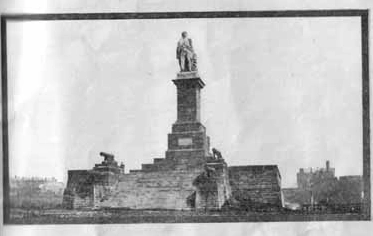
Further to the west stands the colossal monument of Admiral Cuthbert Collingwood—as though guarding his native river—testifying to his greatness. The monument is reached by a flight of twenty-one steps. At the sides of the steps leading to the foot of the monument are four 32-pounder guns of the Royal Sovereign, which took part in the battle of Trafalgar, and achieving the victory which added so much to England’s greatness. The sculptor was Mr. John Graham Lough, a Northumbrian by birth.
The plateau on which the monument now stands was once a solitary island, cut off from the mainland by the northern mouth of the river. The view from this point is one of the most interesting that can be imagined.
Standing on the monument we are reminded of an incident in which Bede tells us how St. Cuthbert in his youth perceived some monks who were bringing timber up the river to the Monastery on the south side of the Tyne when a westerly gale spring up and drove them out to sea. The people on the north bank stood watching them until their small craft looked not larger than so many seagulls riding upon the waves. Instead of sympathising with the unfortunate monks, they jeered at them, saying they were getting their deserts for trampling upon the laws of nature and setting up new and unheard-of standards of life. A lad in the crowd ventured to ask: “Why curse these people, who, as you see, are being driven to their death? Is it not better to pray for their safe return than to be glad of their danger?”
It was St. Cuthbert who thus made so bold a stand upon the cliffs of Tynemouth. We are told that in answer to St. Cuthbert’s prayer the wind miraculously changed and the monks got safely to land.
Still further west is Percy Square, built by the Government in 1758, during the time of the seven years war with France, and used as barracks for 500 soldiers. The men were drilled in the open square, and were stationed there for the protection of the Tyne. There are still a few inhabitants who remember an outer row of houses, including the Northumberland Hotel, at the east corner on the outer side of the square next to the sea. This particular spot has gradually crumbled away and fallen on to the Black Middens.
MASTER MARINERS ASYLUM.
Opposite to Percy Square on Tynemouth Road stands the Master Mariners’ Asylum. It was built in 1838, mainly through the liberality of the third Duke of Northumberland. A clock is encased in its handsome tower, and an imposing statue of His Grace occupies a central position in front of the building.
Before continuing our ramble, I must just mention that between Percy Square and the Mariners’ Asylum stood a toll gate; this was the second gate on the road to Tynemouth, the other being situated at the foot of Hawkey’s Lane. The gates were abolished some seventy years ago.
We shall have to retrace our steps now up the pier road bank, and, following the road to the right this time, we overlook the Short Sands from the promenade, where great improvements have been made since the landslide in 1913.
Further along the road brings us to Sharpness Point, where once stood a two-gun battery during the Napoleonic Wars. At the foot of the cliff here we note the ornamental Bathing Pool, with a water area of 180 feet by 60 feet, and which has proved to be an attractive feature. At this point commences the great stretch of the favourite Long Sands, which reach to Cullercoats.
TYNEMOUTH PLAZA.
Our next point of interest is the Tynemouth Plaza, suggestive of sunny Italy and Spain. This immense building, originally known as the Tynemouth Winter Gardens and Aquarium, was erected in 1877-78 at a total cost of £82,000, and was formally opened on August 28, 1878, by T. E. Smith, Esq., who was at that time the Liberal Member of Parliament for the Borough.
Though its collection of birds, beasts and fishes was very good, the attendances of the public were never such as to bring a satisfactory reward to the shareholders. The building has been in the hands of many companies, and the first sale realised £32,000, its name being changed to The Palace.
In 1914 the Palace was occupied by the Wellesley Training Ship boys, who made its corridors echo with music and song, following the disastrous fire on March 11th of that year, which completely destroyed their old “wooden wall” home.
During the Great War it was commandeered by the Military authorities and used as barracks for the troops, watch being kept night and day for the expected German invader.
Opposite the Plaza is Tynemouth Park, the artificial lake of which is often the animated scene of model yacht competitions.
Standing upon the Grand Parade, 80 feet wide, and looking out to sea, as we drink in the fresh sea breeze, we are reminded of the sentimental song, “The Cliffs of Old Tynemouth,” written by Dr. David Ross Leitch, a native of North Shields.
THE CLIFFS OF OLD TYNEMOUTH.
Oh! The Cliffs of old Tynemouth, they’re wild and they’re sweet
And dear are the waters that roll at their feet:
And the old rained Abbey, it ne’er shall depart,
Tis the star of my fancy, the home of my heart.
Oh! Twas there that my childhood fled cheerful and gay.
There I loitered the morning of boyhood away:
And now as I wander the old beach alone,
The waves seem to whisper the names that are gone.
Twas there with my Alice, I walked hand in hand,
Where the wild waves in moonlight leapt o’er the bright sand:
And sweet were the echoes of the dark cliffs above,
But, Oh! Sweeter her voice as she murmured her love.
Other lands may be fairer, but nought can be seen,
Like the shore where our first love and boyhood have been:
Oh! Give me the Cliffs, and the wild roaring sea,
The Cliffs of Old Tynemouth, for ever for me.
Copies of “A Ramble in Tynemouth and Cullercoats.” and “The Origin of North Shields,” can be had from Mr. William 8. Garen, Estate Agent, 9 Park Avenue, North Shields.
A RAMBLE IN CULLERCOATS.
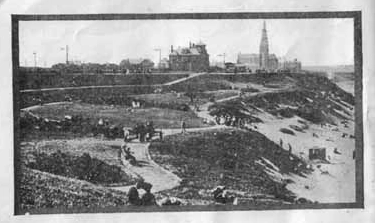
Cullercoats in pre-Reformation times formed part of the Tynemouth Priors’ demesne, and is about 300 years old. It is situated close to the cliffs which overhang the North Sea, and is included within the boundaries of the Borough of Tynemouth.
Its history may be divided into two parts, the old Cullercoats and the new, but it still remains typical of the old Northumbrian fisher stock.
ST. GEORGE’S CHURCH.
The starting point of our ramble is the magnificent memorial church of St. George’s, standing on the site of an old farmhouse called the Links House, situate at the northern end of the Tynemouth Promenade. The church was erected by a former Duke of Northumberland in memory of his father, at a cost of £30,000, and consecrated on December 16, 1884, by Bishop Wilberforce, the first Bishop of Newcastle. It is considered to be one of the best types of parish churches in England and a beautiful specimen of early English architecture. The tall spire, 180 feet high, is a striking landmark for sailors.
At the east end of the church, facing the sea, in a recess of the churchyard wall, is a memorial in the form of a large crucifix which was erected to the memory of 70 men of the village who gave their lives in the Great War. It bears the following inscription:-
Here beneath the shadow of the Cross behold the names of our brethren of Cullercoats, who gave their lives in the Great War. 1914-1918.
Let future generations keep them in continual remembrance, giving unto God the thanks and glory.
Opposite the church is the headland called Tynemouth North Point, at the foot of which a big reef of rocks stretches seaward, known as the Bear’s Back, on which many a good ship has come to grief.
THE SMUGGLERS’ CAVE.
An inlet runs into the Point here, known as the Smugglers’ Cave, once the scene of old smuggling adventures, for in bygone days the greater part of the population of the little village got their means of livelihood by the running of contraband goods.
St. Mary’s Island, farther north, was useful to the smugglers for conveniently landing goods, which were transferred from a lugger at night into small boats, and then run into a deep winding gully called The Smugglers’ Creek, on the north side of the island, near to the gable-end of Crisp’s cottage, from whence they were conveyed inland.
CULLERCOATS.
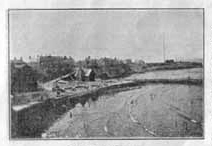
We now continue our ramble across the sands of Cullercoats Bay, and find in the centre of the bay a cave nearly 150 feet long called The Fairies Cave. Close to this cave there once existed 2 wooden pier, and iron ring- bolts were affixed to the rock itself, to which small craft of 100 tons were moored. Two hundred years ago this bay was one of the busiest spots on the coast. It was the shipping place of the Whitley-Monkseaton Collieries, and a wooden wagonway ran from the pits in Whitley to the Cullercoats coal staiths.
About 1688 Captain Grenville Collins, who made a survey of the coast of Great Britain in a yacht named the Merlin, published a book with charts entitled “Great Britain’s Coasting Pilot,” wherein he thus described the harbour:-
“COLLAR COATS is a pier that lieth a mile or more from Tinmouth Castle to the northward, and is a pier where vessels enter at high-water to load coals, and lie dry at low-water. The going in of this place is between several rocks. The way is becon’d.”
Salt-making formed a most important part of the trade of this little port, which had been artificially constructed; but the entrance was difficult.
From August, 1723, to August, 1724, seventy-eight vessels left Cullercoats with coal for foreign ports. The price of coal on shipboard was 9/- per chaldron, and the tax added to this was 6. Owing to flooding and other difficulties the mines were closed. In 1726 Richard Ridley & Co. bought the salt-pans for £456, and had them removed to Blyth; the removal marked the decay of Cullercoats as a shipping port. The last vessel to take salt was the Fortune, of Whitby, and Cullercoats then relapsed into the condition of a quiet fishing village.
DOVE MARINE LABORATORY.
The north-west corner of the bay shelters the Dove Marine Laboratory, erected in 1908 by Wilfred Huddlestone for the furtherance of the study of marine biology. Prior to that time this was the site of the salt-water bath, built by Richard Armstrong in 1807. On payment of a small charge visitors are shown through the Aquarium. In the lower part of the building is the resting-place of the actual boat used by the heroine Grace Darling, who, with her father, made the daring voyage from the Longstone Lighthouse on the Farne Island, and saved nine men from the shipwrecked steamer Forfarshire after the lifeboatmen had failed to reach the wreck in a terrible storm.
A thrill of enthusiasm swept through the world when the gallant deed became known, and Grace Darling was offered £20 a night to appear at the Adelphi, in London, in a scene of the shipwreck, just to sit in the boat, but she refused to leave the island. Only two years after the event, on October 28, 1842, Grace Darling died of consumption in her twenty-sixth year, and lies asleep in the old village churchyard at Bamburgh.
Near the breakwater at the north side of Cullercoats Bay is the lifeboat house, and above it, on the cliff top, is the look-out house, a quaint little edifice, officially opened on October 13. 1879, for the use of members of the Volunteer Life Brigade. This site was at one time occupied by one of the coal staiths leading from the Whitley-Monkseaton Collieries, when the coal was shot over the bank to the vessels below.
Just outside of this building is the village open debating ground, from which a most delightful view may be had of Cullercoats Bay and the coastline, and on a summer evening it is an interesting sight to witness the little fleet of fishing cobles sailing out of the haven, and their lights like fire-flies moving over the surface of the deep.
Across the road stands the Bay Hotel upon the site of the old Ship Inn, in the days of which the corner of Beverley Terrace and Mast Lane was occupied by a large ballast-hill.
CLIFF HOUSE.
On our right is Dial House, another imposing old building. and close to this stands Cliff House, facing the sea. In 1845 it was the residence of the beautiful and accomplished Mrs. Arkwright, who belonged to a family of great Shakespearian actors. She was the daughter of Stephen Kemble (an actor, chiefly remarkable for his enormous bulk, which enabled him to play Falstaff without stuffing), and niece of both Mrs. Siddons, the wonderful Shakespearian actress, and John Phillip Kemble, another renowned actor of our national poet’s plays.
Passing along Front Street, on our left stand Brown’s Buildings, a typical row of fishermen’s cottages, each with one large room only, used for the purpose of cooking and eating meals, sleeping, and making, baiting and repairing the nets. Fortunately, the inmates understand the value of fresh air, the house door being seldom closed, and the good lady, sitting at the courtyard corner, smiles a rubicund invitation to buy her freshly caught lobsters, prawns, crabs, mackerel, etc.
SPARROW HALL.
Not far from here is all that is left of the original building known as Sparrow Hall, so called by the fisherfolk from the ornamentation of a sparrow—though really meant to be a dove—carved on the gable point near to Front Street. The ravages of time, with modern additions consequent on the building being made into tenements, and cottages built upon the garden, have removed this interesting relic of the days gone by.
This mansion was built by Thomas Dove, Junr., in 1682, and is the oldest house in Cullercoats. The Dove family acquired considerable local influence in the neighbourhood, and for upwards of a century had much to do with the development of Cullercoats. Thomas Dove, Senr., of Whitley, came into an estate in Cullercoats in 1621, and bought a water-mill belonging to the Priors of Tynemouth, which stood near where the Marden Burn enters the sea.
One member of the family, John Dove, joined the Society of Friends, and in 1662 enclosed a piece of land in Cullercoats to be used as a private burial-ground for such members of his family and friends as were Independents or Quakers.
In 1872 the Tynemouth Corporation decided to extend John Street to Marden Burn, where it would join Whitley Lane, and this was done, but as the line of road crossed the aforesaid burial ground permission had to be obtained from the Society of Friends, who sanctioned the removal of the bones of the old followers of John Fox, together with the dilapidated headstones, to the south side of Preston Cemetery.
CULLERCOATS FISHERFOLK.
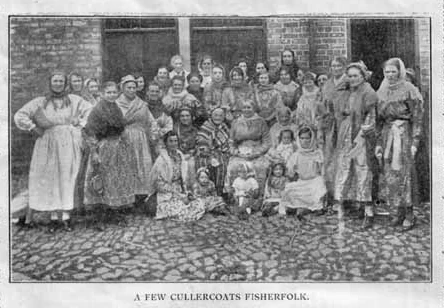
Visitors to Cullercoats are always interested in the fisherfolk, who still retain their old-fashioned customs and superstitions. Those who know them say that, when at sea, they hold it unlucky to speak of a pig, and to whistle in the coble brings a gale.
In his dress the fisherman ensures utility and comfort when going to sea, usually wearing a pair of white flannel trousers of great width and strength, and a jacket and woollen vest of a blue colour; his boots, which are very large and completely waterproof, reach above the knee, thus forming a protection against the wet and cold.
A nobler or braver race than our Cullercoats fishermen it is impossible to find. They are always ready to face the perils of the sea, or to take the lifeboat out to save the poor, distressed toilers of the deep. They grudge no sacrifice, allow no failure to discourage them, and have proved over and over again that they have elements of true nobility.
The Cullercoats fishwife plays a man’s part in helping to launch the lifeboat, frequently wading waist-high in furious and cold waters, and never hesitating, although sending the men to face death and disaster. She is hard-working and industrious, clean, civil and intelligent, with an abundance of lively humour and ready wit. Her picturesque garb of blue flannel, with long shawl entwined about her shoulders, and her creels, has known no alteration for over a century.
THE CULLERCOATS FISH-LASS.
BY NED CARVAN.
As’s a Cullercoats fish lass, as rosy an’ free,
Browt up in a cottage just close to the sea:
An’ Aa sell fine fresh fish, both te poor an’ te rich—
Will you buy, will you buy, will you buy ma fresh fish!
Byeth barefut and barelegged Aa trudge mony a week.
We’ a creel on me back an’ a bloom on me cheek:
Aa’ll supply ye wi’ flat-fish, fine skyet, or fresh ling,
And sometimes pennywilks, crabs, an’ lobsters Aa bring.
Aa work hard for me livin’, frev a frind Aa ne’er begs.
An Aa huff the young gents when they peep at my legs:
Aa’s hilthy and hansom, quite willin’ and strang,
Te toll for me livin’, cryin’ fish the day lang.
THE WIRELESS STATION.
On the north side of Brown’s Point is situated the Marconi Wireless Station, which has a range of 300 miles, and is one of the most important in the country. The receiving mast is 220 feet in height.
MARDEN TOWER AND QUARRY, ETC.
Situate on the new road known as Broadway is an old stone building popularly known as Marden Tower. The windows are in the upper part, and the door, which is nearly halfway up the building, is approached by steps. The small arched chamber below was used for storing the blasting powder used at the magnesian limestone quarry. A cast-iron railway ran from the quarries to the Low Lights, North Shields, from whence the coal and lime was shipped until the lease of the quarries from the Duke of Northumberland to the North Shields Water Company as a reservoir, to be transferred with the turn-over of that company to the Tynemouth Corporation.
In 1860 the Blyth and Tyne Railway Company acquired the abandoned waggonway, and laid a line of rails to Tynemouth, thus establishing a connection with Blyth.
THE MONK’S STONE.
Taking the Broadway towards Tynemouth for a short distance we come in view of the Monkhouse Farm on our right, near which, in a field, may be seen a high and slender stone pillar, locally known as the Monk’s Stone, and for centuries popularly supposed to have been erected to mark the spot where Delaval, Lord of Seaton Delaval, overtook and killed a monk of Tynemouth Priory, and throws a light on the rough life of those days.
The story runs as follows:
A monk of Tynemouth Monastery, catering for the Priors’ table, had wandered some miles north of the Monastery, and, attracted by savoury odours, entered the kitchen at Seaton Delaval Hall while the dinner was cooking. Among the dishes being prepared was a whole hog, ordered specially for Delaval’s own eating. This suited the palate of the monk, and, regardless of the anger of the servants, he cut off the head and put it in his wallet, carrying it away in triumph towards the Monastery. The enraged servants dare not resist the holy man by force, but when the young and fiery Lord of Delaval returned with his friends from hunting and found that what he considered the best part of his dinner gone, he looked upon the theft as a personal insult.
Speedily remounting his horse, he set out in pursuit of the offender, whom he overtook about a mile east of Preston, and so belaboured him with his staff—called a hunting gad—that the monk was hardly able to crawl to his cell. He died within a year, but the story states that the beating was not the cause of his death.
However, contention was sharp between the temporal and spiritual lords, and in those days the boldest spirits had to bend before the power of the Church. The brethren made the monk’s death a handle to charge Delaval with his murder, and before he could receive absolution for his outburst of temper, he was obliged to make over to the Monastery, in expiation of his deed, the Manor of Elsig, in the neighbourhood of Newcastle, along with several other valuable estates, including a summer residence for the Priors of Tynemouth.
Thus Delaval satisfied the demands of the Church by restitution and penance, and returned to his home a sadder and wiser man. The crime was said to be commemorated by an inscription on the stone which every Shields lad knew to run as follows:- “Oh horrid, horrid, horrid deed, to kill a man for a pigge’s hede.” Antiquarian research has found no confirmation for this popular story. Some think the stone was part of the cross that once stood on Tynemouth village green, and was removed to its present position to mark the boundary for the Sanctuary of Tynemouth.
We will conclude our ramble at Holy Saviour’s Church, which is surrounded by a well-kept enclosure. Built by Algernon the Good, the foundation-stone of this church was laid on September 9, 1839, by Mr. Matthew Bell, M.P., who appeared as the representative of His Grace the Fourth Duke of Northumberland, who was unavoidably absent through indisposition. This Good Duke built three churches, with an endowment in each case, as well as the presentation of five parsonages for the County Borough of Tynemouth. This is not an everyday occurrence, and is worthy of being recorded in our local history.
I am sure that the past history, and in some cases the present occurrences, relating to buildings, places, etc., in Tynemouth and Cullercoats are not so generally well known to residents, especially of course the younger generation, and I sincerely hope that our ramble has enlightened many upon some particular point.
Lastly, a word to the older residents of the borough. I trust that, instead of having bored them by reference to past history, I may have happily awakened some dormant enthusiasm, and helped them to recall to mind the “good old days” of their youth.
The Author is indebted to the Proprietors of the Shields Daily News and to 1 Stanley Wilson, Esq., Town Clerk of Tynemouth, for the use of the blocks to illustrate this “Ramble.”
WILLIAM S. GARSON,
ESTATE AGENT.
9 PARK AVENUE, NORTH SHIELDS.
Personal attention is given to the Collecting of Rents: the Management of Property: and the arranging of Mortgages at a Reasonable Rate of Interest.



